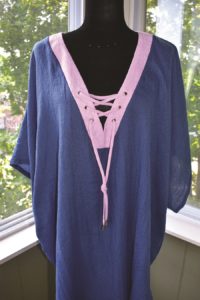Eric Bomyea and Iryna Teixeira, who had met years earlier when they were working at the same marketing agency, were podded together in Quincy during the early months of the pandemic. They would meet up at his apartment or hers every Sunday for brunch and champagne, and, after the eggs had been eaten and the second champagne bottle emptied, they would sit at their sewing machines for hours and make experimental garments out of old bedsheets.

Their goal was to design a piece of clothing that Bomyea, a gay man, and Teixeira, a straight woman, would both feel comfortable in, and that would work for both of their body types — he’s tall and muscular, she’s petite and pregnant.
Teixeira grew up taking sewing classes; Bomyea was a little less experienced, but he had learned how to stitch from his father, who was a nurse in the Navy. They both tinkered away. What they settled on, finally, was a kaftan — a loose-fitting tunic with a wide-open cut at the bottom and undefined sleeves. It’s a shape that has been around since ancient Mesopotamia and has made more than one comeback as resort wear.
Friends liked what they saw coming out of Bomyea’s and Teixeira’s sewing machines, so the two decided to make a business out of their quarantine project. They hired a technical designer, stitched their nicknames together into a brand (Ricky Rinski), and made a plan to produce a batch of 300 pieces. They put them up for sale online and at a pilot pop-up outside Joe Coffee in Provincetown, where Bomyea spends his summers.
It was a well-timed experiment. While men in evening gowns and boas were making waves on the red carpets of Hollywood, the men on Commercial Street began to appear in kaftans — which are, for all intents and purposes, dresses. Gay men everywhere, it seemed, were stepping up to an onslaught of gender-neutral fashion trends.
It has, for some decades now, been common to see men walking down Commercial Street in dresses. What shocks elsewhere delights here. But almost always, a man in a dress here is a man in drag, which is to say, a man playing a persona that is distinct from his day-to-day identity. He takes off the dress, and that is the end of that.
The man in a kaftan seems to be doing something altogether different. At noon, he’s wearing a kaftan over a speedo on his way to the beach. At five o’clock, he still has the kaftan on, but he’s thrown some jewels around his neck and wrists and he’s ready to turn heads at tea dance. The next morning, he’s sitting on his porch, nursing a mug of coffee and maybe a hangover, feeling the breeze between his thighs because he’s still in that kaftan. The man in the kaftan is wearing a dress as himself, allowing it into his day-to-day life.

Bomyea’s and Teixeira’s kaftans, in particular, are well suited for this. In the design process, they borrowed features from traditional men’s clothing. The V-neck and lacing at the top of the kaftan is what you’d see on a vintage hockey jersey. The high-low cut at the bottom, which makes an upside-down “U” at the sides, mimics the way an untucked oxford shirt falls over dress pants. Bomyea and Teixeira also decided to stray from patterns and stick to solid colors.
“We hoped that all of that would help us slowly bring in a more traditionally masculine market,” Bomyea said.
Perhaps the most daring departure from the demands of the fashion world was their decision to opt out of the traditional sizing chart: small, medium, large. They offer two options: “flowy” and “extra flowy.” The point of this, Bomyea said, is to encourage people to think not about what size their bodies are, but how the garments might look: “How much flow do you want?
“When you think of summer, you think of being carefree,” said Bomyea. “And that’s exactly what a kaftan is: carefree.”
